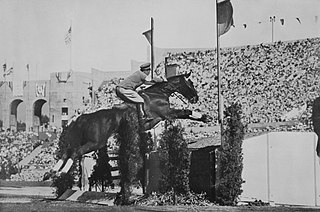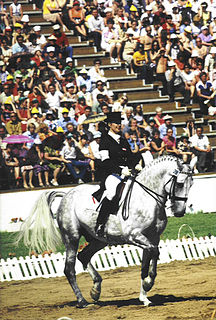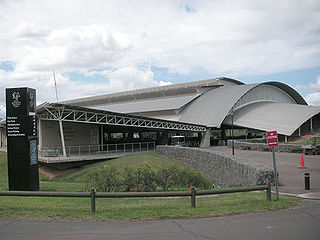 W
WEquestrianism made its Summer Olympics debut at the 1900 Summer Olympics in Paris, France. It disappeared until 1912, but has appeared at every Summer Olympic Games since. The current Olympic equestrian disciplines are Dressage, Eventing, and Jumping. In each discipline, both individual and team medals are awarded. Women and men compete together on equal terms.
 W
WThe equestrian program at the 1912 Summer Olympics in Stockholm, included five medal events. There were individual competitions in dressage, eventing, and show jumping. Team scores were also gathered and medals awarded for teams in the eventing and jumping competitions. Equestrian had been absent from the Olympic program since the 1900 Summer Olympics, making the 1912 Games the second time the sport was featured. Ten nations competed: Belgium, Chile, Denmark, France, Germany, Great Britain, Norway, Russia, Sweden, and the USA. Only Sweden and Germany were able to supply a full team for all three disciplines, with several countries having several riders and horses used in two or even all three disciplines. A total of 88 entries ran in the three events, with 62 riders and 70 horses.
 W
WThe equestrian events at the 1928 Summer Olympics included dressage, eventing, and show jumping. All three disciplines had both individual and team competitions. The competitions were held from 8 to 12 August 1928. Teams were now fielded by three riders, rather than four, the purpose being to reduce pressure on national federations to find that many riders in order to compete for team medals. Riders had to be considered amateurs, which was defined as either an actively serving professional officer, or as a gentleman rider as defined by the rules of that rider's national governing body. A total of 113 entries were present from 20 nations: Argentina, Austria, Belgium, Bulgaria, Czechoslovakia, Denmark, Finland, France, Germany, Hungary, Italy, Japan, the Netherlands, Norway, Poland, Portugal, Spain, Sweden, Switzerland, and the USA. This was the first appearance for Hungary, Japan and Argentina in equestrian events at an Olympics. Additionally, after being shut out from two Olympic competitions, Germany also returned to the Games to win a few medals in the equestrian events.
 W
WThe equestrian events at the 1932 Los Angeles Summer Games included dressage, eventing, and show jumping. The competitions were held from 10 to 14 August 1932. Due to the Great Depression, only 31 entries from 6 nations competed—which was to be the lowest participation of any Olympic Games.
 W
WThe equestrian events at the 1936 Berlin Summer Olympics included dressage, eventing, and show jumping. All three disciplines had both individual and team competitions. The host country, Germany, had a stellar year, winning both individual and team gold in every equestrian event, as well as individual silver in dressage. The competitions were held from 12 to 16 August 1936. Moderately priced tickets meant huge crowds at all equestrian events, with 15,000–20,000 spectators at any time during the dressage competition, 60,000 on the endurance day of eventing, and 120,000 for the Nations Cup in jumping.
 W
WThe equestrian events at the 1952 Helsinki Summer Olympics included dressage, eventing, and show jumping. All three disciplines had both individual and team competitions and were held from 28 July to 3 August 1952.
 W
WThe equestrian events at the 1960 Summer Olympics in Rome included dressage, eventing, and show jumping. Eventing and show jumping presented both individual and team medals, dressage presented only individual medals. The competitions were held from 5 to 11 September 1960. 159 entries, including 8 women, competed from 29 nations: Argentina, Australia, Austria, Belgium, Brazil, Bulgaria, Canada, Czechoslovakia, Denmark, Egypt, France, Germany, Great Britain, Hungary, Ireland, Italy, Japan, Korea, New Zealand, Poland, Portugal, Romania, Soviet Union, Spain, Sweden, Switzerland, Turkey, Uruguay, and the USA. The youngest participant was Min Gwan-Gi from South Korea at 18 years old, while the oldest rider was Lilian Williams from Great Britain at 65 years old.
 W
WThe equestrian events at the 1964 Summer Olympics in Tokyo included show jumping, dressage and eventing. All three disciplines had both individual and team competitions. The competitions were held from 16 to 24 October 1964. These events took place at Karuizawa, which would become the first city to host Summer and Winter Olympic event when it hosted the curling events for the 1998 Winter Olympics in Nagano.
 W
WEquestrian at the 1980 Summer Olympics was represented by six events. All of them, with the exception of the Individual Jumping Grand Prix, were held in the Trade Unions' Equestrian Complex, which is situated in the Bitsa Forest Park. Individual Jumping Grand Prix was held in the Grand Arena of the Central Lenin Stadium at Luzhniki.
 W
WThe equestrian events at the 2000 Summer Olympics in Sydney included dressage, eventing, and show jumping. All three disciplines had both individual and team competitions.
 W
WThe events of the equestrian at the 2004 Summer Olympics featured three equestrian disciplines: dressage, eventing and jumping. All three disciplines are further divided into individual and team contests for a total of six events.
 W
WThe individual show jumping in equestrian at the 1936 Olympic Games in Berlin was held at the Olympiastadion (jumping) on 16 August. The competition was also referred to as the "Prix des Nations." There were 54 competitors from 18 nations, with each nation having a team of three riders. The results of the individual event were used for the team jumping event as well. The individual event was won by Kurt Hasse of Germany, the nation's first victory in individual jumping and first medal in the event since 1912. Romania and Hungary each earned their first individual jumping medals, the former with Henri Rang's silver and the latter with József von Platthy's bronze.
 W
WThe individual show jumping in equestrian at the 1948 Summer Olympics in London was held at the Wembley Stadium on 14 August. The competition consisted of a single round of jumping. In the case of a tie in points, a jump-off was arranged. The jump-off had no time limit, however, the time taken to complete the jump-off was used as a tie-breaker. The points from the individual competition were also used in the team competition. There were 44 competitors from 15 nations, with nations able to send up to three riders each. The event was won by Humberto Mariles of Mexico, with his teammate Rubén Uriza taking silver at the top of a three-way jump-off for second place. Mariles' win was Mexico's first victory in the event. Jean-François d'Orgeix of France earned that nation's first individual jumping medal since 1928 with his bronze.
 W
WThe individual eventing in equestrian at the 1956 Olympic Games in Helsinki was held from 30 July to 2 August. Only 34 of the 59 starters were able to finish the competition, with 20 being disqualified in the cross-country, 3 more retiring during that phase, and 2 being disqualified in the jumping.
 W
WThe team eventing in equestrian at the 1952 Olympic Games in Helsinki was held from 30 July to 2 August. Only 33 of the 57 starters were able to finish the competition, with 19 being disqualified in the cross-country, 3 more retiring during that phase, and 2 being disqualified in the jumping. This left only 6 of the 19 teams with all three riders finishing.
 W
WEquestrian sports are among those contested at the Summer Olympic Games. Equine events began at the Olympics in 1900, when competitions in polo, vaulting, four-in-hand driving, mail coach driving, mixed hacks and hunters and three types of jumping were held. Most of these events were later discontinued, although equestrian events have continued through the 2016 Summer Olympics, and now include team and individual dressage, three-day eventing and show-jumping. Competitors in the modern pentathlon event also have to complete an equestrian show-jumping course, but this is not part of the equestrian events.
 W
WFor the Summer Olympics, there are 53 venues that have or will be used for equestrian. From 1912 to 1992, the events took place in more than one venue. Since the 1992 Summer Olympics, the equestrian events have taken place on a single venue in an effort to reduce costs. During the 1964 to the 1980 Summer Olympics, an equestrian event was the final event before the closing ceremonies of the respective Olympics. The last equestrian event that took place at the main stadium was at the 1988 Summer Olympics though it was not the final event before the closing ceremonies. That honor would fall for the end of the men's marathon event. Stockholm Olympic Stadium is the only equestrian venue to serve host for more than one Summer Olympics, doing so in 1912 and 1956.